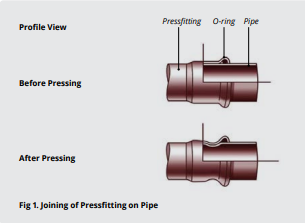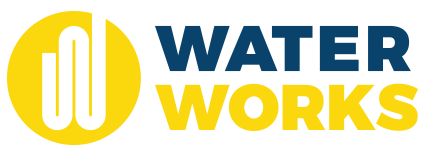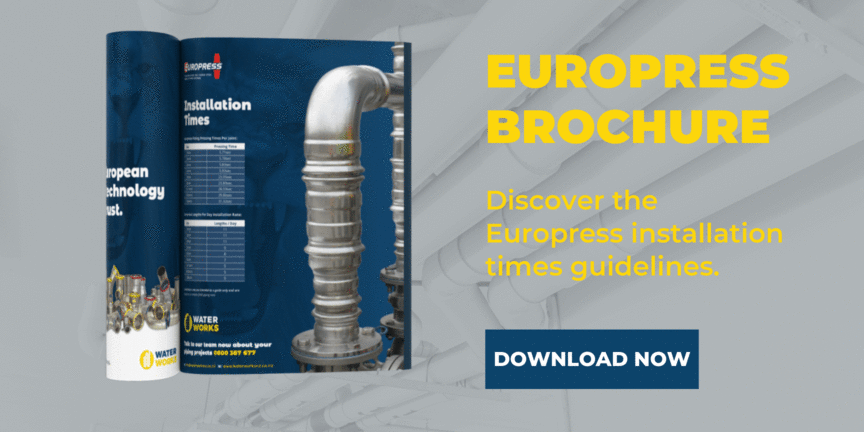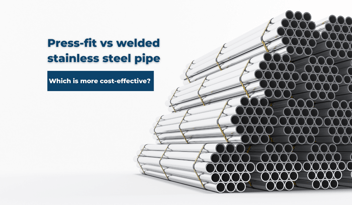Press-fit VS welded piping: Which should I choose?
For all pipeline trade professionals, connecting pipes efficiently and to a high standard is a vital component of every project. Traditionally, welding has been a reliable and proven jointing method, however, there have been developments such as press-fit solutions that equally have their place in the market. Both press-fit and welded piping installation methods offer various advantages which we will shed some light on in this article. We will also outline the key differences between press-fit and welded piping, key applications, and the pros and cons of either option.
What is the difference between press-fit and welded piping?
Welding is a method whereby localised extreme heat is used to fuse two pieces of metal together. Common welding techniques used in piping projects include MIG welding and TIG welding. Metal Inert Gas (MIG) welding is the process whereby an electric arc forms between a MIG wire electrode and a metal surface causing them to fuse. Tungsten Inert Gas (TIG) welding uses a gas-shrouded arc from a tungsten electrode to produce the weld connection.
In contrast, press-fit piping is a method that requires no welding and the connection is simply pressed using a battery-powered pressing tool. The pressing process produces two deformations. The first, radial deformation, compresses the o-ring in the toroidal chamber and guarantees the pipe is hermetically sealed. The second, geometric deformation of both fitting and pipe creates a mechanical joint, resistant to slipping and rotation.
The resulting pressing profile varies according to diameter. The below image shows an assembled joint before and after pressing. Joints produced in this way are extremely strong but flexible enough to withstand the stresses resulting from initial installation and those, such as vibrations and thermal expansion, which occur in normal operating conditions.

The Europress range is a prime and top-quality example of press-fit piping available in both carbon steel and stainless steel. The Europress system, in particular, uses a specialised German manufactured hydraulic pressing tool that applies pressing jaws or chains, sometimes called pressing collars, over the crimp-end, joining the pipe in a single step.
Speed of installation
Welded piping installation speed
The speed of welding as a piping installation method largely depends on the requirements of the project itself. Although welding is often viewed as the slower of the two approaches, this is largely the result of the physical labour requirements to complete a joint to the required level of integrity or finish. Fully sealed, or purge welded joints are a necessity for certain jobs, for example, high-pressure or hygienic applications, and cannot be overlooked.
Factors affecting weld speed are not limited to but may include the thickness of the material, type of weld required, pipe diameter, position, accessibility, and complexity of joins.
Press-fit piping installation speed
Press-fit installation offers a different method of connecting pipework. While it’s not suitable for all of the same applications traditional welding covers, there are many situations where it can be applied for reduced installation times.
Looking at Europress specifically, it has been observed to have up to 10 times faster installation time than conventional steel piping systems. This is a result of the one-step fitting process where the battery-powered pressing machine merely takes a few seconds to join the pipes. A great example of this is seen at the Pernod Ricard winery where Europress was attributed for reducing the installation time from an estimated 24 weeks using welded tube and fittings to 13 weeks. The flow-on effect from the speed of installation is project savings of up to 30%.
Pros and cons of Press-fit and welded piping
/The%20Importance%20of%20Getting%20Your%20Pipe%20Bracketing%20Right.jpg?width=5184&name=The%20Importance%20of%20Getting%20Your%20Pipe%20Bracketing%20Right.jpg)
Welded piping pros
Welded piping materials are generally lower cost
Welded piping is typically lower cost in regards to the materials costs, while press-fitting materials tend to come at a higher cost due to the higher complexity of the fitting and, in several cases, a heavier wall thickness compared to common steel tubes. As a rough guide, for a welded system, engineers estimate the overall cost to be ⅓ materials and ⅔ labour. Press-fit reverses this ratio to ⅔ materials and ⅓ labour.
Welding professionals deliver reliable results
Seasoned professional welders deliver reliable results that stand the test of time as properly sweated fittings typically last the life of the pipe itself. Correctly welded fittings are known to withstand significant fluctuations in temperature and pressure, offering the project a long-term and sustainable solution. For the highly skilled welder, there’s nothing quite like a precise and neatly welded joint that serves as a permanent connection. It’s safe to say that welding has its desirable applications, and for good reason.
Smooth bore for hygienic applications
A properly completed purge welded connection leads to a near smooth bore of the pipe or tube. This is critical for hygienic applications, such as food lines, as it eliminates any opportunity for food to become trapped in the pipeline and bacteria to grow. This is one application where press-fit connections cannot be used.
Higher pressure capability
A welded or fused join can withstand higher pressure within a pipeline compared to a press-fit or mechanical type connection. This means a welded connection is better suited for high-pressure applications such as steam or high-pressure gas.
Welded piping cons
Welding processes are a greater hazard in a work environment. For example, the use of heat produces a fire risk which is particularly seen on industrial sites such as in the oil and gas industry, or in the food and beverage industry where poly panels are used frequently. This risk means installers are required to hold time-consuming hot work permits which can result in fire watch requirements which add an additional labour resource to the process increasing installation costs.
Similarly, another common challenge of traditional welding is the gases and fumes that are a product of the process, particularly in confined or unventilated areas. Welding fumes contain potentially harmful complex metal oxide compounds so it’s vital to protect your face from the fumes and ensure proper ventilation to limit exposure.
Press-fit piping pros
High safety standards
By removing the need for gas bottles, hoses, or naked flames press-fit prioritises safety. An added benefit to this is there’s no need to gain a hot works permit for installation and the connections can be completed in higher risk environments. In addition, the tooling is lightweight making it easy to access tight spots and get around a worksite.
Efficient and low-cost installation
Weld-free technology can be faster to install which often lowers the overall cost of the project. Press-fittings are pressed in one step using a battery-powered crimping tool which only takes a few seconds.
Precision
The Europress tooling, in particular, has preset torque settings that ensure every joint is perfectly pressed with an accurate amount of torque in one simple action. The battery-powered machine is fully equipped to provide faultless installation in every application which significantly reduces the possibility of human error.
Effective labour usage
Press-fit piping can be installed by any competent installer. This provides more options for organisations when delegating their labour resources, allowing for less experienced installers to tackle the task while reserving more experienced installers for complex jobs like high pressure or process pipework.
Press-fit piping cons
Press-fit tube is inserted into a press-fitting and pushed up to a shoulder. Where the tube butts up against the shoulder is classified as a trap point where bacteria can develop meaning press-fit won’t be suitable for hygienic applications.
It’s important to note that both installation methods have their place across projects and industries and one is often better suited than the other. As the New Zealand importer and distributor of Europress, but also a distributor for traditional welding solutions, Waterworks provides an extensive range of tube and fitting options for both applications. Providing our clients with a variety of high-quality options ensures you can have a safe, efficient, and quality installation. Talking to the team at Waterworks enables us to work with you to find the best solution for your project, regardless of the methods used. There are so many benefits to gain from opting for a press-fit solution, so why not see if Europress’ press-fit technology is suitable for your next project? To discover the Europress range, simply contact our specialist team today or download the Europress installation times brochure.

%20(1).png)


.png?width=352&name=WW%20%20Blog%20headers%202023%20(3).png)
